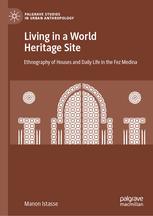- Faculté de Philosophie et Sciences sociales
- Accueil
- Publications en Sciences sociales et Sciences du travail
-
Partager cette page
Living in a World Heritage Site
Through a thick ethnography of the Fez medina in Morocco, a World Heritage site since 1981, Manon Istasse interrogates how human beings come to define houses as heritage. Istasse interrogates how heritage appears (or not) when inhabitants undertake construction and restoration projects in their homes, furnish and decorate their spaces, talk about their affective and sensual relations with houses, face conflicts in and about their houses, and more.

Through a thick ethnography of the Fez medina in Morocco, a World Heritage site since 1981, Manon Istasse interrogates how human beings come to define houses as heritage. Istasse interrogates how heritage appears (or not) when inhabitants undertake construction and restoration projects in their homes, furnish and decorate their spaces, talk about their affective and sensual relations with houses, face conflicts in and about their houses, and more. Shedding light on the continuum between houses-as-dwellings and houses-as-heritage, the author establishes heritage as a trajectory: heritage as a quality results from a ‘surplus of attention’ and relates to nostalgia or to a feeling of threat, loss, and disappearance; to values related to purity, materiality, and time; and to actions of preservation and transmission. Living in a World Heritage site provides a grammar of heritage that will allow scholars to question key notions of temporality and nostalgia, the idea of culture, the importance of experts, and moral principles in relation to heritage sites around the globe.
Dates
Créé le 5 septembre 2019
Auteur(s)
Istasse Manon, Postdoctoral Researcher at the Laboratoire d’Anthropologie de Mondes Contemporains (LAMC) at Université Libre de Bruxelles, Belgium.
Éditeur
Palgrave: https://www.palgrave.com/gp/book/9783030174507#aboutBook
